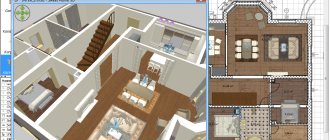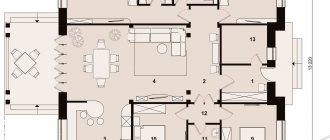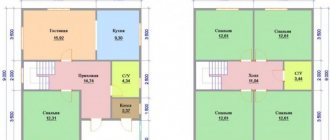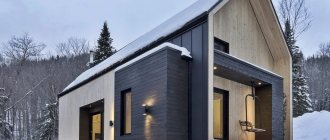Minka (literally "people's house(s)") is a traditional Japanese house.
In the context of the division of Japanese society into classes, minka were the dwellings of Japanese peasants, artisans and merchants, i.e. non-samurai part of the population. But since then, the class division of society has disappeared, so the word “minka” can be used to refer to any traditional Japanese houses of the appropriate age.
Minks have a wide range of styles and sizes, which is largely due to geographical and climatic conditions, as well as the lifestyle of the inhabitants of the house. But in principle, minka can be divided into two types: village houses (noka; nōka) and city houses (machiya; machiya) . In the case of village houses, a subclass of fishermen's houses can also be distinguished, which are called gyoka.
In general, surviving minkas are considered historical monuments, and many are protected by local municipalities or the national government. Of particular note are the so-called gasshō-zukuri , which survive in two villages in central Japan - Shirakawa (Gifu Prefecture) and Gokayama (Toyama Prefecture). Collectively, these buildings have been listed as a UNESCO World Heritage Site. The peculiarity of these houses is their roofs, which meet at an angle of 60 degrees, like hands folded in prayer. Actually, this is reflected in their name - “gassho-zukuri” can be translated as “folded hands”.
The central principle in the construction of the mink was the use of cheap and accessible building materials. The peasants could not afford to import something very expensive or use something that was difficult to find in their home village. So, almost all nokas are made exclusively from wood, bamboo, clay and various types of grass and straw.
The “skeleton” of the house, roofs, walls and supports are made of wood. fusuma screens were used instead .
Grasses and straw were also used to make roofing, mushiro mats and tatami mats. Sometimes the roof, in addition to thatch, was covered with baked clay tiles. Stone was often used to create or strengthen the foundation of a house, but stone was never used in the construction of the house itself.
As in other forms of traditional Japanese architecture, wooden supports supported the bulk of the structure, so that "windows" could be created in any part of the house. The supports formed the "skeleton" of the house, connecting to the cross beams in an ingenious structure without the use of nails, and the "holes" in the walls of the house were made using shoji and heavier wooden doors.
Gassho-zukuri are perhaps the most recognizable Japanese houses, and also the tallest - due to their outstanding roofs in every sense. High roofs made it possible to do without a chimney and arrange extensive storage areas, and also, first of all, to protect the house from moisture. Thanks to the design of the roof, snow or rain immediately rolled down without stopping, making the roof practically “waterproof”, and the straw covering it almost did not rot.
There are three main roof styles, which share a number of similarities with the roofs of other styles of Japanese architecture. Most machiya have gable, gabled "kirizuma" roofs , covered with roofing shingles or tiles. In contrast, most noka were either thatched (yosemune) and had roofs sloping on four sides, or their roofs were made with multiple gables and covered with shingles and thatch (irimoya).
Special caps were installed at the roof ridge and at the junctions of various sections. The tiles or shingles that covered the roofs often served as the only artistic decoration of the houses, plus the roof ridges were decorated with ornaments.
The interior decoration of a mink was usually divided into two sections. In the first of them, an earthen floor was left, this area was called “home” (doma), and in the second, the floor was raised 50 cm above the level of the house and covered with tatami or musiro . The house was used for cooking and other agricultural needs. As a rule, it contained a kamado clay stove , a wooden washbasin, barrels for food and jugs for water.
A large wooden ōdo door served as the main entrance to the building. A built-in irori hearth was often built into the raised floor , but no chimney was built to connect the hearth to the outside environment. Only sometimes a small ventilation window was made in the roof. The smoke went up, under the roof, so that the residents did not breathe it or soot, but nevertheless the smoke stained the straw, which had to be changed often.
A Japanese house is such an original structure that it is difficult to say who influenced whom: either the inhabitant of this home expressed his life philosophy through it, or, on the contrary, the house formed the peculiar habits of those who live in it.
A Japanese house is a canopy, and a canopy over an empty space . This is primarily a roof supported by a frame of wooden rafters and supports. There are no walls or doors in our understanding, because in each room three of the four walls can be moved apart at any time, or even removed altogether. When such sliding doors, easily removed from the grooves, serve as external walls, that is, they act as windows, they are covered with white rice paper, similar to tissue paper, and are called shoji.
When you first see the inside of a Japanese home , what strikes you most is the complete absence of any furniture. All you see is the exposed wood of the support posts and rafters, the ceiling of planed boards, the latticework of shoji , the rice paper of which softly diffuses the light coming from outside. Under your bare feet, the tatami springs slightly—hard, three-finger-thick mats made of quilted straw mats . The floor, made up of these golden rectangles, is completely empty. The walls are also empty. There are no decorations anywhere, except for a niche where a scroll with a painting or a calligraphed poem hangs, and under it there is a vase of flowers: ikebana.
One thing is certain: the traditional Japanese house in many ways anticipated the innovations of modern architecture. Frame foundations and sliding walls have only recently gained recognition among builders, while removable partitions and replaceable floors are still a thing of the future.
A Japanese house is designed for summer. Its interiors are really well ventilated during humid heat. However, the dignity of a traditional Japanese home is reversed when it is equally desperately drafted in winter. And the cold here makes itself felt from November to March. The Japanese seem to have come to terms with the fact that it is always cold in the house in winter. They are content to warm their hands or feet, without even thinking about heating the room itself. We can say that in the tradition of Japanese housing there is no heating, but heating.
Only when you feel with your skin in a Japanese house what its closeness to nature turns into on winter days, do you truly understand the meaning of the Japanese bath - furo: this is the main type of self-heating. In the daily life of every Japanese, regardless of his position and income, there is no greater joy than soaking in a deep wooden vat filled with incredibly hot water. In winter, this is the only opportunity to truly warm up. You need to get into the furo after first washing yourself out of the gang, like in a Russian bathhouse, and rinsing thoroughly. Only after this do the Japanese plunge up to their necks into hot water, pull their knees up to their chin and blissfully remain in this position for as long as possible, steaming their body until it turns crimson red.
In winter, after such a bath, you don’t feel a draft for the whole evening, from which even the picture on the wall sways. In summer it provides relief from the sweltering humid heat. The Japanese are accustomed to bask in furo, if not every day, then at least every other day. Having that much hot water for each person would be an unaffordable luxury for most families. Hence the custom of washing from the gang so that the vat remains clean for the whole family. In villages, neighbors take turns heating furo to save on firewood and water. For the same reason, public baths are still widespread in cities. They traditionally serve as the main place of communication. After exchanging news and gaining some warmth, the neighbors disperse to their unheated homes.
In the summer, when Japan is very hot and humid, the walls move apart to allow the house to be ventilated. In winter, when it gets colder, the walls are moved to create small interior rooms that can be easily heated with braziers.
The floor of a traditional Japanese house is covered with tatami - square straw mats . The area of one tatami is about 1.5 square meters. m. The area of a room is measured by the number of tatami mats that fit in it. The tatami mats are cleaned and replaced periodically.
In order not to dirty the floor, in traditional Japanese houses they do not wear shoes - only white tabi socks . Shoes are left at the entrance to the house on a special step - genkan (it is placed below floor level).
They sleep in traditional Japanese houses on mattresses - futons, which are put away in the closet in the morning - oshi-ire . The bedding set also includes a pillow (previously a small log was often used as such) and a blanket.
They eat in such houses, sitting on futons. A small table with food is placed in front of each eater.
One of the rooms of the house must have an alcove - tokonoma. This recess contains art objects that are in the house (graphics, calligraphy, ikebana), as well as cult accessories - statues of gods, photographs of deceased parents, and so on.
Traditional Japanese house
The traditional Japanese house (Minka) in modern Japan is represented by only a few museums. However, these buildings, although belonging to the past, are an integral part of the country's architecture and culture.
Tour of the history of Japanese houses
Traditional houses are simple one- or two-story frame buildings made of wood, paper, straw, clay, and bamboo. The higher the status of a resident of the country, the more expensive the materials, the brighter the façade was decorated. It is the elements of rich houses and temples that make the Japanese style of architecture recognizable.
Frame construction technology has long been used in earthquake-prone Japan. The buildings erected on it were characterized by increased stability, made it possible to survive a fall, and could be quickly restored.
Its architectural features
Japanese corpses affected the climatic conditions of the country. On most islands of the Japanese archipelago, winter is quite mild. Along with the idea of closeness to nature, this determined the construction of the walls.
Traditional Japanese houses had only one empty wall, where the space between the supports was filled with grass covered with clay. The rest are sliding or removable panels with a light wooden frame covered with rice paper. The frame was not damaged by their removal, the integrity of the structure was not compromised. At the same time, the house was well lit by the sun, the boundary between it and nature was erased.
Design features of houses
Japanese corpses built decades and centuries ago were very different from modern houses. They were characterized by the following features:
- The structure of the house is a system of posts and beams connected without nails. Instead, they used advanced technology to cut logs and logs.
- The center of the building is a pillar that is resistant to shocks.
- The roof has two or four slopes. Prefers external walls one meter apart. This protects the façade from rain and sunlight.
- I rose half a meter from the first floor
. This was done to provide ventilation to the lower tier of the structure to keep warm during the cold season. This is important for the Japanese who sleep on a mattress instead of a regular bed.
Traditional Japanese houses were far ahead of their time. The basic ideas of their construction are the basis of modern frame technologies. One of them, naturally, is called “Japanese”.
Interior of a traditional house
In traditional Japanese houses there were no clear divisions into rooms. The most free, open space can be freely transformed using fusuma light screens. Thus, the large room in which guests were received during the day was divided into bedrooms and occupied with screens in the evening.
With such mobility, there was no question of shared heavy furniture. Instead of cabinets for storing clothes and household items:
- niches decorated with the same screens;
- baskets;
- chests of drawers;
- wicker box;
- low cabinets with drawers.
The bed served as a mattress. futon
, and the floors were covered with hard straw mats - tatami.
The dining room, kitchen and utility rooms were equipped in close proximity to the large clay oven.
Finishing materials supported: thick white paper, wooden boards, plaster. The twilight of the rooms was slightly diluted by a lamp in the shadow of a paper called a tail.
Style motivation
Why is the Japanese house a phenomenon? Because its very nature goes against our usual concept of home. Where, for example, does the construction of an ordinary house begin? Of course, from the foundation, on which strong walls and a reliable roof are then erected. In a Japanese home, everything is done the other way around. Of course, it does not start from the roof, but it also does not have a foundation as such.
When building a traditional Japanese house, the factors of a possible earthquake, hot and extremely humid summer are taken into account. Therefore, it is basically a structure made of wooden columns and a roof. The wide roof protects from the scorching sun, and the simplicity and lightness of the structure allows the damaged house to be quickly reassembled in case of destruction. The walls in a Japanese house are just filling the gaps between the columns. Typically, only one of the four walls is permanent; the rest consist of movable panels of varying density and texture, which play the role of walls, doors and windows. Yes, in a classic Japanese house there are no windows that we are used to!
The outer walls of the house are replaced by shoji - these are wooden or bamboo frames made of thin slats assembled like a lattice. The spaces between the slats used to be covered with thick paper (most often rice paper) and partially covered with wood. Over time, more technologically advanced materials and glass began to be used. Thin walls move on special hinges and can serve as doors and windows. During the hottest part of the day, the shoji can generally be removed, and the house will receive natural ventilation.
The interior walls of a Japanese house are even more conventional. They are replaced by fusums - light wooden frames covered with thick paper on both sides. They divide the home into separate rooms, and if necessary, they can be moved apart or removed, forming a single large space. In addition, the interior spaces are separated by screens or curtains. Such “mobility” of a Japanese house gives its inhabitants unlimited possibilities in planning - according to needs and circumstances.
The floor in a Japanese house is traditionally made of wood and rises at least 50 cm above the ground. This provides some ventilation from below. Wood heats up less in hot weather and cools down longer in winter; moreover, it is safer during an earthquake than, for example, masonry.
A European person entering a Japanese home has the feeling that this is just the scenery for a theatrical production. How can you live in a house that practically has paper walls? But what about “my home is my castle”? Which door should be bolted? Which windows should I hang curtains on? And which wall should you put the massive cabinet on?
In a Japanese home, you will have to forget about stereotypes and try to think in other categories. For for the Japanese, what is important is not “stone” protection from the outside world, but the harmony of the inner.
Modern Japanese house
Modern Japanese houses in the individual housing sector are also built using frame technology. However, their appearance is influenced by fashion trends and the use of the latest facade materials.
Frame design in Japanese
A modern Japanese home almost always looks European. But you can recognize it by the laconic, smooth surface of the outer walls; abundance of translucent glass; bright geometric shapes
.
The characteristic idea of closeness to nature is embodied in the form of terraces and balconies with glass window sills.
The following features can be distinguished in the design of modern houses in Japan:
- The foundation is a monolithic "insulated Swedish oven" which is basically an insulating "dough" and a layer of concrete on top of it.
- The floor, as in a traditional house, is raised above ground level. Only now they do this by installing concrete "ribs" from a height of 50 cm on the base plate.
- External walls are insulated with spray polyurethane foam.
- The warmest islands do not have central heating like traditional buildings. It is being replaced by infrared panels, electric and gas heaters.
A beautiful Japanese-style house is a unique complexity of traditions and the results of scientific and technological progress.
Evolution of the interior - what has changed
Over the past 30-40 years, the Japanese lifestyle has changed. I also changed the interior of the house. Became more European. Due to this:
- Reduced area for household needs.
- Rooms have become personal spaces with a clearly defined functional purpose.
- There was tall furniture on legs.
- The rooms were divided into “Western” (in the middle of the house) and “Japanese” (in the back of the building), where the interior was designed in a traditional style.
- Tatami floors are being replaced by modern flooring because they cannot bear the weight of furniture on your feet.
- Dark wood in the interior is replaced by light, and plaster is replaced by wallpaper with a similar texture.
The interior of a Japanese home is still dominated by the principle of minimalism
, environmental friendliness and closeness to nature.
If you were born in Japan, you can build a house or decorate its rooms in classic Japanese style, and the culture of this country is alien to you. Otherwise, style your most open space with accents from decor to furniture.
Before the arrival of Buddhism in Japan, traditional house building was widespread, it was called minka
.
Mostly these were people who did not belong to the samurai estate: peasants, merchants and other people. Old
Minki
houses
were built in the traditional style of this country.
Nowadays there is no division between samurai and ordinary mortals, so every traditional apartment
.
Minky and the Russian Chamber
- this is something common. However, the traditional Japanese roof immediately catches the eye. It seems to be huge and worn like a hat at home. This is called "gaze-zukuri", which means "folded hands". This mink name was given for the resemblance of the arches to the folded hands of a praying Japanese man. Depending on the region of the country and climatic conditions, minks are divided into several different types. The most common "knocks" are in the village, as well as in the city of "Matija". There are minks in fishing villages - “damn”.
Traditional Japanese Architecture
Traditionally, minki were made from cheap and easily available materials: wood, bamboo, straw, clay and other materials. Ordinary peasants could not afford expensive raw materials. In a traditional Japanese apartment
without main walls. The entire structure rests on a frame, and the walls themselves can be freely moved for ventilation. The internal layout of such a house is also distinguished by its uniqueness. Typically Japanese houses are built on two floors.
The kitchen is closer to the exit and is directly on the dirty floor. Typically a clay stove and a wooden sink are installed. In other rooms, half a meter above the ground, a tatami-covered partition was installed to replace the floor. The rest of the building is usually divided into four parts, but because of the sliding walls, the layout of the house can be easily changed. Inside the house
everything is designed for people sitting on the floor.
The bathroom and toilet were usually built outside the house, in separate rooms. I was in Japan
, you simply must see Mina because the spirit and character of the entire nation is kept in a traditional apartment.
Start your tour Japanese style
from a traditional Japanese house.
Many articles about the Japanese home mention Minka,
which literally explains people's home.
Minka is the home of peasants, artisans, merchants, but not samurai. Minka can be divided into two types: country houses (noka) and city houses (machiya). In turn, in rural houses one can distinguish a separate type of traditional Japanese fishermen's houses, called gyokami.
Minka was built from cheap and inexpensive materials. The frame of the house was made of wood, the outer walls were made of bamboo and mud, and there were no inner walls, instead there were partitions or a screen made of fusum. Grass and straw were used to make the roof of the house, tatami mats and mats. Rarely, the roof was covered with baked clay tiles; stone strengthened the foundation of the house.
| Rys. 1 |
Inside the hole there are two sections, the first was a clay floor (this part was called home), the second rose 50 cm above the level of the house and was covered with tatami. Four rooms were allocated in the “white” part of the house. Two rooms are residential, including the one in which the fireplace was located. The third room is a bedroom, the fourth is for guests. The toilet and bath were outside the main part of the house.
A section of the House was used for cooking and clay was installed in it. kamado oven
(Kamado), wooden sink, barrels of food, jugs of water. Essentially, Doma is the grandma of the Japanese-style kitchen; it's a kitchen you won't want to replicate in your home.
| Rice. 2 Kamado stove in a Japanese house |
The entrance to the main building was closed by a large single door (odo), and an iriri hearth
(irori). Smoke from the hearth rose under the roof of the house, sometimes through a small hole; there was no chimney. An irori fireplace was often the only way to illuminate a house in the dark.
Inner world
To some extent, the house in which we live reflects our character, vision of the world, and aspirations. The atmosphere inside the house for the Japanese is perhaps the most important thing. In the interior, they prefer minimalism, which allows them not to overload the space and energy of the house. Everything is extremely functional, compact and light.
When entering the house, you must take off your shoes to your socks. In Japanese tradition, socks are white, because the house is always perfectly clean. However, maintaining it is not so difficult: the floor is lined with tatami - dense mats made of rice straw, covered with igus grass - swamp reed.
There is practically no furniture in the house. The one that exists has been reduced in size to a minimum. Instead of bulky cabinets, there are built-in wardrobes with sliding doors that match the texture of the walls. Instead of chairs there are pillows. They usually eat at low portable tables. Instead of sofas and beds, there are futons (mattresses filled with pressed cotton) . Immediately after waking up, they are put away in special niches in the walls or in built-in closets, freeing up space for living.
The Japanese are literally obsessed with cleanliness and hygiene. At the border of the sanitary zones of the house - the bathroom and toilet - special slippers are placed, which are worn only in these rooms. It is worth recognizing that in the absence of excess furniture, unnecessary trinkets and non-functional items, dust and dirt simply have nowhere to accumulate, and cleaning the house is reduced to a minimum. In a classic Japanese house, everything is designed for a “seated person.” And sitting on the floor. In this you can see the desire to be closer to nature, to the earth, to the natural - without intermediaries.
Light is another Japanese cult . A house where both the external and internal walls are made of translucent materials allows a lot of natural light to penetrate, even if all the shoji are closed. Their lattice frames create a special light pattern. The main requirement for light in a Japanese home is that it be soft and dim. Traditional rice paper lampshades diffuse artificial light. It seems to permeate the air itself, without drawing attention to itself, without distracting.
Clean space and peace - this is what the interior of a Japanese house should provide to the inhabitant. If we can decorate our rooms with flowers, vases, souvenirs and over time we even stop noticing these things, then the Japanese make only one accent in the interior decoration of the premises (painting, ikebana, netsuke), which will please the eye and set the atmosphere. Therefore, in every home there is a wall niche - tokonama , where a neat Japanese will place the most beautiful or valuable thing he has.
Samurai house
Samurai house
was fenced with gates: the larger they are and the better decorated, the higher the status of the samurai. The basis of the house's structure is made up of supporting columns; the house has a rectangular shape and is raised on stilts 60-70 cm from the ground, which protects it from moisture and mold.
| Rice. 4 Samurai Residence |
The house visually resembles a curtain frame house, but is only partially demolished depending on the season. The outside walls that face the street are fixed and immovable, but the wall from the yard moves. This wall was called amado, it looks like a shield of interlocking wide boards, installed on cold days or at night shoji
.
Finishing facilities
Particular attention in Japanese interior design is paid to decoration. To transform your apartment, you can use materials such as:
- maple, kiri, cedar, sugi wood;
- stone slabs;
- bamboo, reed;
- silk.
To decorate a room, instead of natural wood, you can choose laminate, and to replace silk, you can choose any similar fabric. To finish the ceiling, use matte paint, tension panels, wallpaper or fabric. A multi-level and differently designed ceiling will add interest, thus designating a separate zone.
Combining materials will add greater artistic beauty to the walls. The design of a Japanese-style room involves the presence of stonework, which goes well with wallpaper, and wood with matte paint. Floors are traditionally made of wood, stone or pebbles. Tatami, carpets made of coarse thread or reeds will also bring coziness to the apartment.
Machiya - Japanese town houses
Machiya
are traditional wooden townhouses that, together with country houses (noka), represent Japanese folk architecture (minka).
Machiya in Kyoto has been the standard defining the form of Machiya throughout the country for many centuries. I mean, if you want to see the reality of Matia,
go to Kyoto.
| Figure 8-9. Machiya in Kyoto |
A typical Machiya is a long wooden house with a street frontage. The house itself can have a height of one or one and a half, two or even three floors.
There was often a store in front of the building, which was covered from the outside by shutters that were raised or extended. This part of the house was the "shop space" of the house.
The rest of the house is the so-called “living space”, which consists of rooms for various purposes, including storing goods, receiving clients and guests, cooking or relaxing.
| Rice. 10 Schematic illustration of Machiya |
Characteristic finishing in imitation of Japanese styling
See alsoOriental style in the interior, photo.
Floor
The Japanese walk barefoot at home, so a comfortable warm floor is valued. The modern heated option is not necessarily used, just natural wood and tatami-type mats. Our interpretation of Japanese-style apartment design uses imitation of natural wood. Use parquet boards and laminate in light shades or dark, but with an expressive textured pattern of expensive wood.
See also African style in the interior: features, photos
Walls
In modern styling, much that is traditional has been lost, for example, 2 types of walls - external (main) and internal (partitions). Geometric designs in the form of sectional grids covered with light fabric or thick rice paper - this solution is not found in any other style. A modern Japanese-style room design should take all this into account.
Japanese style in the interior
Japanese style room design
See alsoEthnic style in the interior of a modern apartment
Ceilings
Asian ethno style is unusual in all its manifestations, including the design of the ceiling. These are wooden beams, which in modern styling are used as lintels for suspended ceilings and structures for original lighting. Multi-level ceilings with matte stretch fabric would be appropriate.
See alsoShabby chic style interior: features, photos
Plumbing
The same smooth lines and laconic shapes, clear geometry and rounded bowls. This is a wooden bathtub of an unusual shape - a “dugout” made from a single piece of large wood and an oval washbasin. Reflecting the Japanese style in the interior of your apartment, you can limit yourself to a wooden podium for a bathtub and a countertop for a sink. The shower is minimalistic in the literal sense of the word, there is only a hole for water in the floor behind a glass partition, a tap in the wall, and a jet divider under the ceiling.
Unusual room design in Japanese style
Large beautiful room in Japanese style
See alsoProvence style in the interior of a city apartment
Color
The main palette is natural, calm, natural, especially in wall decoration. Shades reflect natural materials:
- red – shades of autumn foliage and the rising sun, without acidic or unnatural undertones;
- black and dark brown are typical of the Japanese palette, but only in the form of linear contrasts;
- white, milky, sand and light beige tones are the basis of wall design;
- pale shades of gray and blue, like fog and sea pebbles on the shore, are also common in Japanese interiors;
- pink and all shades of sakura flowers are used in decor, but not as the main background (a modern bedroom is an exception);
- natural greenery is also welcome in the decor.
Interesting. The green palette has its own names for each shade. A Japanese schoolchild can name up to 57 shades of green - “pine needles”, “moss”, “young bamboo shoots”, “lime”, “spring sakura leaves”, etc. Each of them has its own hieroglyph, which children study in art lessons art. Therefore, you should approach the choice of shade responsibly, giving preference to natural colors.
Japanese style in the interior of the room
Japanese style room design
See alsoHow to decorate a kitchen interior in Japanese style
Tree
Natural wood is welcome in everything - furniture, wall and ceiling surfaces, even plumbing fixtures. In the Japanese style of interior design, great importance is attached to the outlines of wood products:
- simple geometry;
- grace of sinuous lines;
- laconic elegance of forms.
See alsoCreate an original design of a children's room for a girl
Curtains
Initially, they were not intended, since Japanese windows had a sliding design with a canopy on the outside and did not have tulle curtains on the inside. Rice paper roller curtains replaced the elaborate European window treatments. Screened fabrics appeared much later, and what we call “Japanese curtains” were widely used as interior partitions.
Japanese style in the interior
Yellow room in Japanese style
A modern Japanese curtain is a flat fabric screen on large windows with a weighting insert inserted into the lower fold of the panel. They move to the sides using a special curtain rod for Japanese curtains, mainly electrically driven with remote control, which is very convenient. The fabric can be chosen arbitrarily; it is important that it allows light to pass through, soft and dim, which is highly valued in a traditional Japanese home. The coloring should emphasize the characteristic features of the style:
- elegant geishas with fans;
- hieroglyphs;
- exotic birds;
- bamboo shoots;
- sakura branch;
- careless sketches of traditional landscapes.
Japanese style in the interior
Beautiful Japanese style bedroom
See also Empire style in the interior - luxury worthy of an emperor
Decor and accessories
Typically Japanese style in the interior can be emphasized with “Japanese accents” alone, if it is simple stylization or imitation, in the bathroom, bedroom or living room. Having selected a suitable porcelain tile for tiling the bathroom, you can lay out a panel with a picture in the center of the room. The living room and bedroom will be decorated with traditional ikebana or blooming orchids. Hieroglyphs, screen curtains, pictures as part of Japanese-style decor are easy to make with your own hands. Dishes for sushi and tea ceremony can be purchased at any supermarket or specialized online stores.
Japanese style in the living room interior
Dark interior of a room in Japanese style
Bright room design in Japanese style
See alsoMediterranean style in interior design
Lighting
We don’t use a traditional round-shaped lamp made of rice paper, but you can always find a frosted glass product on sale in the form of a sconce or floor lamp. Perhaps, due to the earthquake zone, the Japanese do not use volumetric ceiling chandeliers, so it is better to limit yourself to original ceiling lighting and local lighting.
Japanese minimalism in the interior is inimitable, but it has its own charm, which is why it has so many adherents. Many examples of laconic design were developed by specialists, which we suggest using in your home. Some successful examples are in our photo gallery.
See alsoDecor in Provence style. Create a unique atmosphere of France with your own hands!
This is interesting: Staircase on a metal frame - the basics of strength (56 photos)
Shoji and Amado
Amado when it fits tightly together, the outermost Amado was locked with a bolt lock. This wall resembles a clunky, large compartment door that has been placed in external storage built on the edge of the wall, and the box itself can also be wall mounted. In many projects, Amado was completely shot, raised and hooked with special hooks.
| Rice. 14 Traditional Japanese Minka House |
| Rice. 18 Amado Gets Hooked |
| Rice. 21 Engawa - traditional Japanese house |
| Rice. 22 Engawa in modern interpretation |
Shoji performs the function of both windows and doors and partitions. Shoji shoji
written in English.
In modern terms, shoji are traditional Japanese sliding internal partitions that work on the principle of a partition. The frame and internal partitions of such doors are made of wooden bamboo rods.
| Rice. 24 Project Shoji |
Shoji's design - the top and bottom rails are reminiscent of modern partitions for aluminum systems.
I barely called the interior space of Shoji a compartment by analogy with our door - a filling covered with paper, which the Japanese themselves call washi paper.
Washi paper is made from fibers of mulberry (goat, goat), Gampi bush, Mitsumata and with the addition of bamboo, wheat and rice fibers. Because of this last component, the paper is incorrectly called rice paper.
Traditional washi production technology ensures natural whitening without the use of chemicals, making the material environmentally friendly. The paper is strong and flexible.
The Japanese house was divided into rooms with sliding partitions. There is not much difference between sliding doors and partitions. The main difference in terms is if the door is closed it is a fusuma door and it is always an opaque partition, if the whole room is blocked or a very large opening it is a sliding shoji partition.
Japanese architecture and its features
If we talk about Japanese architecture, you don’t need to be an experienced designer or specialist in order to note its originality. Japanese houses, pagodas and temples have nothing in common with European architecture; they look very unusual and attractive. To build a private house in Japanese style you need:
- Take into account Japanese culture, their canons and traditions, rules and prejudices.
- Give a private house classic features of the Japanese style, using basic design elements that emphasize the home’s belonging to the eastern direction.
- Properly design a personal plot, taking into account the requirements of Japanese architecture, style and features of landscape design. Optimally, the house should be combined with its surrounding area, landscape and its key elements.
- Don’t just copy the key elements of the structure, but repeat their design style. A house made in the Japanese style is complex in its implementation due to the nuances and details that distinguish it from the generally accepted canons of architecture.
Fuzuma Door
Fusuma
- This is a wooden frame glued on both sides with washi paper. Richer Japanese silk door finish. The opening of the fusuma door was carried out similarly to the shoji door, that is, according to the principle of a compartment door. The fusuma door was equipped with an integrated handle, the design of which was also the subject of special attention.
| Rice. 34 Interesting modern interpretation of Japanese partitions |
By the way, another interesting photograph of movable partitions from a house-museum in Kamamura, Japan and a similar design already in a modern house.
The use of wooden grids when creating furniture facades already indicates the Japanese style. The photo below shows an interesting design solution in this style when creating a stand for equipment.
Is it comfortable to live in such a building?
Ancient Japanese houses reflect the philosophy of the country's people. They are adapted to local living conditions. However, such a way of life will be unusual for a European or Russian person. A feature that residents of other regions pay attention to is the adaptability of everyday life to a sitting position. The necessary actions are performed without getting up. This also applies to cooking. At the same time, the height of the ceilings does not limit movement in any way. This distinguishes a Japanese house from a European one.
Modern Japanese housing looks a little different. There are lightweight frame beds and other small-sized furniture. However, life still remains unusual for other peoples to live in.
Corridor or genkan in a Japanese house
In a Japanese house there is something similar to a hallway that we understand. The large difference in height between the entrance and the transition to the house is noteworthy. Such a drop has special cultural significance and acts as an "airlock" that separates the interior of the house from the heating and the cold, unheated entrance.
Almost every genkan
There is a shoe cabinet and a getabako bench. In this corner, the Japanese leave their shoes and put on slippers.
A few more photos of Genkan, but in a modern version. I am adding a photo because the topic of minimalism in furniture is interesting to me. Bright colors and lots of wood are reminiscent of Scandinavian style.
Interior Design
The interior design of a traditional home in Japan must comply with certain rules. The first is the use of materials characteristic of the local nature. The use of natural wood and bamboo is easily explained by their availability, which allows you not to be limited in consumption. Although the thatched roof wears out within a year, it is easily replaced and does not place significant physical stress on the static fortifications of the mink. Tatami is also made from straw, since as a flooring it retains heat well, absorbs excess moisture and is quickly changed if necessary. Rice paper is the only building material that requires pre-production.
The second rule of Japanese style is minimalism. There should be no unnecessary items in the house that are not used daily. Walls made from sliding partitions are sometimes painted with hieroglyphs or drawings in some places. The only decorative area is located near the hearth, where family members and guests cook and eat. A vase is usually placed here, near which a papyrus with decorative painting or verse is hung in a special small recess. Also, the interior design does not involve a lot of furniture. A low dining table and a burner for cooking are all that can be found in a Japanese home. In addition, there is a closet in each room used as a bedroom. It contains a straw mattress, blanket and pillow. These items are used as a bed and are cleaned every morning.
You may be interested in: English-style house designs: varieties and advantages
Colors in the setting
The main colors of a classic interior in Japan are light shades of rice paper and bamboo, combined with dark wood shades. For greater variety, drawings or hieroglyphs are depicted on static walls, but their color echoes the general color style.
Ancient Japanese houses reflect the philosophy of the country's people. They are adapted to local living conditions. However, such a way of life will be unusual for a European or Russian person. A feature that residents of other regions pay attention to is the adaptability of everyday life to a sitting position. The necessary actions are performed without getting up. This also applies to cooking. At the same time, the height of the ceilings does not limit movement in any way. This distinguishes a Japanese house from a European one.
Modern Japanese housing looks a little different. There are lightweight frame beds and other small-sized furniture. However, life still remains unusual for other peoples to live in.
Hibati
Portable fire pits are an interesting part of the Japanese home. Hibati
traditionally used for heating in the Japanese home.
Hibachi were originally carved from wood and covered with clay, then ceramics and metal. Again, rich Japanese craftsmen turned the hibachi into an art piece, depending on the degree of decoration.
| Rice. 54. Ceramic hibachi |
| Rice. 55. Brown hibachi |
These hibachi were shaped like a pot, sometimes shaped like a wooden pedestal with a charcoal container inside. Now these pots are used more as decoration to create a Japanese-style interior
.
Hibati in the form of cabinets resembles a modern stove, which was already used not only for heating, but also for making a kettle.
Features of a Japanese home
The traditional home of Japanese commoners is called Minka. Since ancient times, artisans, traders and everyone who did not belong to the noble class or samurai built precisely such dwellings for themselves. Minks, in turn, are divided into:
- matii - the house of a city dweller;
- goka - a building in which fishermen and their families lived;
- noka - traditional peasant dwelling;
- gassho-zukuri is a house that was built in mountainous areas.
The roof of the noka was made of shingles or straw. In matiya, tiles and tiles are used for this.
Eastern style in house construction Source ooogidrostroy.ru
Irori and Kotatsu
In addition to hibachi, more efficient heating methods have appeared in the Japanese home: irori
and
kotatsu
. Irori is an open hearth that falls onto the floor not only heated around it, but also boiled water.
| Rice. 65-66. Kotatsu |
Hello, dear readers - seekers of knowledge and truth!
Japan for Europeans is like a completely different world. The life and lives of the Japanese are so unusual for us that, of course, we are interested in getting to know this country and learning about its traditions and culture. And today we will open the veil of secrecy and look into a Japanese house.
We invite you to explore traditional Japanese buildings inside and out, as unusual pieces of furniture and household items are called, and to compare how people lived in ancient and modern times.
A blanket with the smell of the sun in a house made of wood and paper.
Every year more people sleep on a bed, but according to a 2013 Nifty survey, at least half of Japanese sleep the old-fashioned way, with a futon mattress laid out directly on top of a tatami mat. During the daytime, the futon is rolled up and placed on a special shelf in the closet, thus freeing up additional space in the room. From time to time, the futon is dried directly in the sun for the purpose of disinfection and also to prevent the mattress from becoming damp. If you keep your futon clean, it will remain soft and comfortable for a very long time. Only in winter it’s cold in a Japanese room. You have to put a yutampo heating pad in the futon, use a heater or kotatsu, warm up in the o-furo and after that dive into a warm futon.
All ready for bed: traditional Japanese futon mattress
Nowadays, if you choose to stay overnight in a hotel or ryokan in a renovated traditional house, as is now fashionable, then in this “old” new space, created using natural materials, you can finally take a little break from your usual everyday life, and your trip it will turn out unforgettable. Be sure to try to get to know this unique world, created with the help of craftsmanship that has come down to this day from ancient times. Enjoy the world of wood and paper, a world of calm and tranquility.
Banner photo: A cat naps on a sunny engawa veranda.
Photo credits: Hallway-genkan: TANAKA Juuyoh Yukimi-shoji: Halfrain Hiiragiya: Caldwell Bishop
Homes in the past
Types of apartments
Traditional Japanese houses are called Minka, which means "people's housing." They were inhabited by ordinary people who did not belong to the noble classes and samurai.
As a rule, the inhabitants of these houses were engaged in crafts, fishing, agriculture and trade. Minka, like the ancient ones, is now preserved only in rural areas.
Depending on the profession, the types of minks are distinguished:
- matiya - for city dwellers;
- noka - for peasants, peasants and peasants;
- goka—for fishermen;
- gassho-zukuri - for mountaineers in remote settlements.
Machiya - home in Japan
The latter have special significance and historical value. The so-called apartments in the mountainous areas of Honshu. The owners of gassho-zukuri were engaged in agriculture, so they needed a spacious ground floor for drying food and an attic for the production process.
Gassho-zukuri in the villages of Gokayama and Shirakawa are included in the UNESCO World Heritage List.
Appearance
Inexpensive materials that were easy to find were used to build the burrow. The frame was made of solid wood, beams, the facade was made of wood, clay, bamboo using elements of grass and straw.
Particular attention is paid to the roof. Due to the lack of chimneys, unique structures were built with high roofs with multiple slopes and roofs that did not allow moisture to be retained in the form of snow and rainwater. The roof of the roof was tiled, tiled, and the roof was thatched.
Even the most modest families tried to surround themselves with a picturesque garden with green plants and decorative elements in the form of small ponds and bridges. There were often separate utility rooms. The house had a veranda - an angava, and also a main entrance - one.
Interior decoration
Minka starts from the corridor - Genkan. Here they take off their shoes before going inside.
A typical house is divided into two parts: a floor covered with earth and high niches raised 50 centimeters with wooden supports. The Japanese spend almost all their time on the floor: resting, talking, eating, sleeping.
Mashiro and tatami are made of high quality bamboo on the floor. Despite their simplicity, they are very beautiful. ,
convenient and practical.
Since ancient times, the Japanese have operated not only on square meters, but also on tatami mats measuring 90 by 180 centimeters.
There are no separate rooms as such, since load-bearing walls are not used in space. Their role is played by movable partitions and shoji sliding doors.
The space surrounded by such screens turns into a room - Wasitsa. When guests are expected to gather, the partitions are simply removed to create one large living room.
What amazes the Japanese home is its amazing order. This is partly due to the neat Japanese housekeepers, partly to the minimalism in the internal structure. There is furniture, half of which, for example, cabinets and storage compartments, are built-in. Japanese-style decor is also quite modest and features paintings, ikebana, calligraphic elements and kamidan niches such as an altar.
The main piece of furniture is the kotatsu. This is a table with a top, around which there is a blanket or a special mattress - a futon. Looking at the kotatsu from the inside will help you see the fireplace underneath, which helps keep you warm.
The kitchen, bathroom and toilet are separated from the common area. The minced bathroom was always separate. Also famous is the Japanese bathhouse ofuro, where all family members often wash in the same water after rinsing in a special room.
Japanese style
Of course, time and technological progress have changed the way of life and housing in Japan. Classical Japanese houses now remain only in rural areas. But every Japanese tries to preserve the spirit of national traditions in their home. Almost every Japanese apartment, even the most modern and “European” apartment building, has at least one room in a traditional style. And this is not a tribute to fashion, but something natural and logical, without which a Japanese cannot imagine his home.
The style of minimalism also prevails in Europeanized Japanese housing - it perfectly corresponds to the conditions of scarcity and high cost of square meters, overloaded with the stress of life in megacities. The attitude towards one’s space, towards residential territory in overpopulated Japan is reverent, because out of the seven thousand islands under the Japanese flag, only 25% of the land is suitable for living.
Japanese interior design has not lost its relevance over many centuries, and this is confirmed by its popularity all over the world. From Japan came the fashion for remodeling apartments with the expansion of the recreation area by demolishing unnecessary walls and doors, the tendency to conditionally divide the space with screens, whatnots, floor patterns or ceiling reliefs.
After the era of chipboard, plastic and toxic dyes, the world has returned to the healing properties of breathable wood, the warmth of natural materials and natural colors - something that Japanese home improvement traditions . The main thing in a Japanese interior (both classic and modern) is compactness, convenience and environmental friendliness. Movable walls, strict decor, mysterious ikebana - in all this there is an incomprehensible desire for the modern consumer consciousness to make the simple multifunctional and at the same time even simpler. A kind of minimalism of the material world, leaving space for contemplation, reflection, and admiration of the spiritual.
By and large, for the Japanese there is no division of his existence into the inner and outer world. There is a single whole, indivisible neither by walls nor concepts. For the Japanese, a home is a part of nature, its continuation, so it must have an energy and aura similar to nature. And this will ensure natural harmony in the lives of its inhabitants.
House
Changes
Modern reality dictates its conditions, technology does not stand still, new materials appear instead of old ones, and this, of course, affects architecture.
There are several trends you can follow that are changing the face of traditional homes:
- When one-story buildings are replaced, houses with 2-3 floors come.
- The size of the house depends on the size of the family - parents try to give each child a separate corner.
- Due to the hot and humid climate, houses become more open and breathable.
- In some regions prone to earthquakes and tsunamis, houses are built on stilts.
- Only frame structures made of wood and reinforced concrete are allowed.
- The imagination of architects develops along with technology, so more and more futuristic buildings with non-standard geometry and layout appear.
- Houses with a dome are gaining popularity - they are made of high-tech polystyrene in the shape of a hemisphere, they are in no way inferior to conventional structures.
- In modern interiors, traditional tatami mats are beginning to coexist with classic Western sofas, sofas and sofas.
Dome houses in Japan
Modern knockout
In rural areas, changes in the external and internal decoration of houses are not as obvious as in the city. Here the apartments remain quite traditional, with thatched roofs and bamboo exterior walls still present.
The average area of a country house is 110-130 square meters. It consists of a living room and 4-5 bedrooms. The kitchen and dining room with Kamado fireplace for cooking are usually located separately on the terrace.
Townhouses
Nowadays, brick, iron, concrete and bituminous materials are most commonly used in buildings. There are not as many vacant spaces in or around the city as in rural areas, so the shipyards are narrow and elongated.
Such space restrictions also affect the size of the buildings - they rarely exceed 80 square meters. There are bedrooms, a living room, a kitchen and even a commercial or workshop space if the owners need them. The attic is built under the roof to provide storage space.
Apartamenty
The Japanese, seeking a good life, a prestigious profession and consistently high wages, gather in large cities, especially Tokyo. The high population density and relatively small area make it necessary to build tall residential buildings with small apartments.
The average area of such an apartment is on average 10 m2, which in itself makes logistics and miracles inventive.
In one room there are:
- lobby;
- combined enclosed bathroom;
- bedroom;
- kitchen;
- built-in storage solutions;
- balcony for drying clothes.
Richer people can afford a spacious apartment of 70 square meters. or a house in the private sector in the city.
Modern housing in Japan
The average size of a house/apartment in Japan is 5 rooms. There are three bedrooms, a living room and a kitchen/dining room. The living area of such a house is about 90 square meters. m. For private houses, this is, respectively, 6 rooms and about 120 sq. m. m of living space. In Tokyo, where housing prices are significantly higher, apartments and houses are on average one room smaller.
The vast majority of Japanese children have their own room (for each child).
Modern Japanese homes almost always have at least one traditional-style room . The remaining rooms are usually made in European style, with wooden floors, carpets, beds, tables, chairs and so on.
In modern Japanese houses it is cold to walk in tabi (the floor is not heated), so the Japanese wear slippers. There are special slippers for the toilet to avoid spreading dirt. In general, the Japanese are very scrupulous about personal and home hygiene.
It is not customary to wash in Japanese baths and saunas. They are designed to relax in hot water after a hard day. It is customary to get into the bathroom and go to the bathhouse only after first washing in the shower. Usually in the evenings the whole family takes a bath, and in the same water - it is very expensive in Japan. Usually the water in the bath is heated to 40°.
In general, Japanese housing is worse and more expensive than in most European countries and America. Many modern Japanese houses are reminiscent of Khrushchev's five-story buildings in design and quality of construction, and in terms of amenities they may even be worse.
About 60% of Japanese people live in their own homes. The rest either rent housing or live in houses provided to them by the company they work for or the government. There are, of course, homeless people, but not that many.
Most private houses are located in the suburbs of large cities or in rural areas. To get to work, the Japanese take trains.
The main means of transportation in big cities is Japanese public transport (subway and buses). However, two out of every three Japanese have a driver's license and own a car. You can get a license to drive a motorcycle from the age of 16, and a license to drive a car from the age of 18. Between cities, the Japanese prefer to travel by rail, the high-speed train system - Shinkansen .
Some interesting facts.
- In Japan there is no such thing as central heating. To combat a cold, there are electric blankets, heaters, baths, and kotatsu.
- The Japanese do not sleep in cribs, but on kotatsu mattresses, which are so compact that they can easily fit in a closet.
- Japanese women have many different dishes and appliances in their kitchens - from dishwashers and bread makers to rice cookers and electric grills.
- Before entering the toilet, you should wear shoes designed specifically for that room.
- The best description of Japanese interior design style is minimalism, harmony, cleanliness and asymmetry.
We learned that traditional Japanese housing is called Minka. Ordinary people lived here, and in some areas such houses have survived to this day.
Family members spend most of their time on the floor, so the main task is to create a comfortable space filled with warmth and harmony with a minimum of furniture and decor. Over the course of several centuries, the living conditions and daily habits of people in the Land of the Rising Sun have changed slightly, which makes their homes unique in their own way.
Let harmony and comfort never leave your home. Join us - subscribe to the blog, and together we will search for the truth!
There has always been a fashion for an apartment built in an unusual style. But Japanese houses are very different from imitations of Dutch, Italian or French architecture. Western design always aims for practicality and all modern conveniences. Japanese homes are a showcase, a continuation of family traditions and a glimpse into ancient culture.
Even a person unfamiliar with Eastern culture who once looked at a Japanese apartment will confirm that it is very beautiful and unusual. Why don't you build a house like this? When planning, it is enough to take into account several nuances.
The building should have classical elements and features characteristic of Japanese architecture. The house adjacent to the room should be designed in accordance with the requirements of oriental tradition and style. The landscape and surrounding vegetation are like an extension of the apartment.
Also, Japanese house designs require special walls, roofs and floors. Of course, it will be very difficult to comply with all the architectural canons of the Land of the Rising Sun, especially if you learn about its culture. Therefore, it may make sense to contact specialists who can help you develop an appropriate project.
In fact, real Japanese houses are difficult to recreate due to the scale of nuances and details. Therefore, when building an apartment, it is worth copying not the elements themselves, but the design style. And chances are you'll have to remake something Western to suit your needs.
Home address
Most streets in Japan have no names. The address of the house in such cases is indicated descriptively (“the third house from the fork after the supermarket”) or in accordance with the numbering within the block. The houses are numbered in order of construction, so the problem of orientation in the city and finding the right building is very acute. Modern cars are equipped with special satellite navigation systems for this purpose.
It can be argued that the Japanese construction industry, especially residential construction, is gradually beginning to distance itself from the old, truly ancient methods, when a hired team of carpenters erected a traditional house in the national style, focusing on the individual wishes of the customer. Now, most often, negotiations with the customer begin with viewing standard house models, which differ only in the details of finishing and interior design.
More than 15 percent of new houses are now being built from standard blocks and parts manufactured in-line at construction plants. The volume of production at such plants is growing year by year, not excluding the possibility of individual construction; Japanese builders are increasingly moving to cheaper in-line methods of standardized construction of houses.
Details and decor
As already mentioned, a small number of decorative elements and accessories are welcome in the Japanese interior style. The most authentic additions could be:
- Floor vases;
- Branches of cherry blossoms;
- Japanese fans;
- Ikebana;
- Samurai daggers;
- Images of hieroglyphs;
- Sliding screens for zoning space;
- Caskets;
- Netsuke figures;
- Dwarf bonsai trees.
When decorating a Japanese interior, you must remember that everything in it is aimed at creating an atmosphere of calm and relaxation.











